英语语言学概论第八章笔记
- 格式:doc
- 大小:5.45 MB
- 文档页数:17
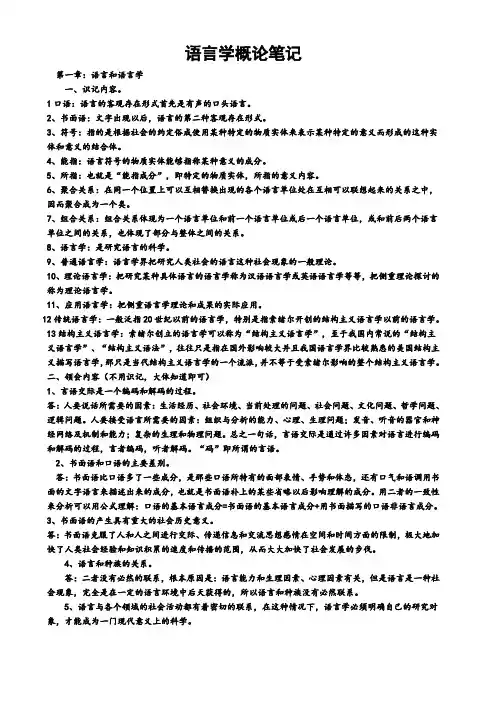
语言学概论笔记第一章:语言和语言学一、识记内容。
1口语:语言的客观存在形式首先是有声的口头语言。
2、书面语:文字出现以后,语言的第二种客观存在形式。
3、符号:指的是根据社会的约定俗成使用某种特定的物质实体来表示某种特定的意义而形成的这种实体和意义的结合体。
4、能指:语言符号的物质实体能够指称某种意义的成分。
5、所指:也就是“能指成分”,即特定的物质实体,所指的意义内容。
6、聚合关系:在同一个位置上可以互相替换出现的各个语言单位处在互相可以联想起来的关系之中,因而聚合成为一个类。
7、组合关系:组合关系体现为一个语言单位和前一个语言单位或后一个语言单位,或和前后两个语言单位之间的关系,也体现了部分与整体之间的关系。
8、语言学:是研究语言的科学。
9、普通语言学:语言学界把研究人类社会的语言这种社会现象的一般理论。
10、理论语言学:把研究某种具体语言的语言学称为汉语语言学或英语语言学等等,把侧重理论探讨的称为理论语言学。
11、应用语言学:把侧重语言学理论和成果的实际应用。
12传统语言学:一般泛指20世纪以前的语言学,特别是指索绪尔开创的结构主义语言学以前的语言学。
13结构主义语言学:索绪尔创立的语言学可以称为“结构主义语言学”,至于我国内常说的“结构主义语言学”、“结构主义语法”,往往只是指在国外影响较大并且我国语言学界比较熟悉的美国结构主义描写语言学,那只是当代结构主义语言学的一个流派,并不等于受索绪尔影响的整个结构主义语言学。
二、领会内容(不用识记,大体知道即可)1、言语交际是一个编码和解码的过程。
答:人要说话所需要的因素:生活经历、社会环境、当前处理的问题、社会问题、文化问题、哲学问题、逻辑问题。
人要接受语言所需要的因素:组织与分析的能力、心理、生理问题;发音、听音的器官和神经网络及机制和能力;复杂的生理和物理问题。
总之一句话,言语交际是通过许多因素对语言进行编码和解码的过程,言者编码,听者解码。
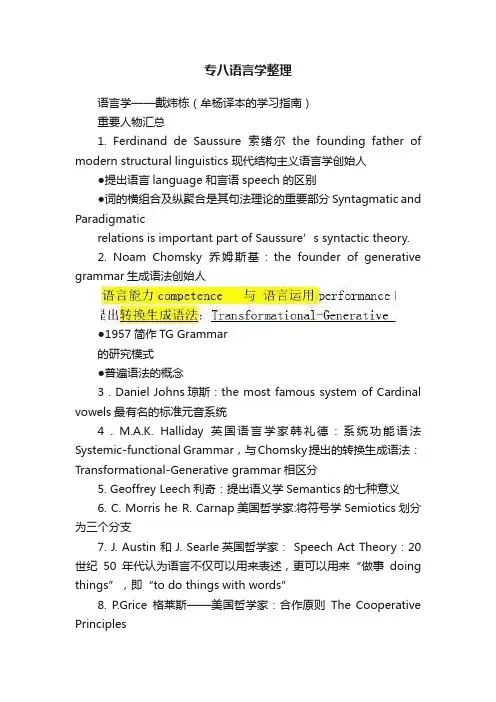
专八语言学整理语言学——戴炜栋(牟杨译本的学习指南)重要人物汇总1. Ferdinand de Saussure索绪尔the founding father of modern structural linguistics 现代结构主义语言学创始人●提出语言language和言语speech的区别●词的横组合及纵聚合是其句法理论的重要部分Syntagmatic and Paradigmaticrelations is important part of Saussure’s syntactic theory.2. Noam Chomsky乔姆斯基:the founder of generative grammar生成语法创始人●1957简作TG Grammar的研究模式●普遍语法的概念3.Daniel Johns琼斯:the most famous system of Cardinal vowels最有名的标准元音系统4.M.A.K. Halliday英国语言学家韩礼德:系统功能语法Systemic-functional Grammar,与Chomsky提出的转换生成语法:Transformational-Generative grammar相区分5. Geoffrey Leech利奇:提出语义学Semantics的七种意义6. C. Morris he R. Carnap美国哲学家:将符号学Semiotics划分为三个分支7. J. Austin 和 J. Searle英国哲学家: Speech Act Theory:20世纪50年代认为语言不仅可以用来表述,更可以用来“做事doing things”,即“to do things with words”8. P.Grice格莱斯——美国哲学家:合作原则The Cooperative Principles9. Ogden and Richards 奥登和理查兹——semantic triangle or triangle of significance语义三角理论p63Chapter one Introduction1.语言学的定义:对语言进行的科学研究(the scientific study of language)2.语言学的范围语音学音位学语言学内部的主要分支形态学句法学语义学语用学社会语言学跨学科分支心理语言学应用语言学规定性与描写性共时性与历时性言语与文字3.语言学中的一些重要区分语言与言语语言能力与语言运用传统语法与现代语言学4.语言的定义5.语言的识别特征6.语言的作用术语双解1.linguistics(语言学):Linguistics refers to the scientific study of language.对语言进行科学研究的学科。
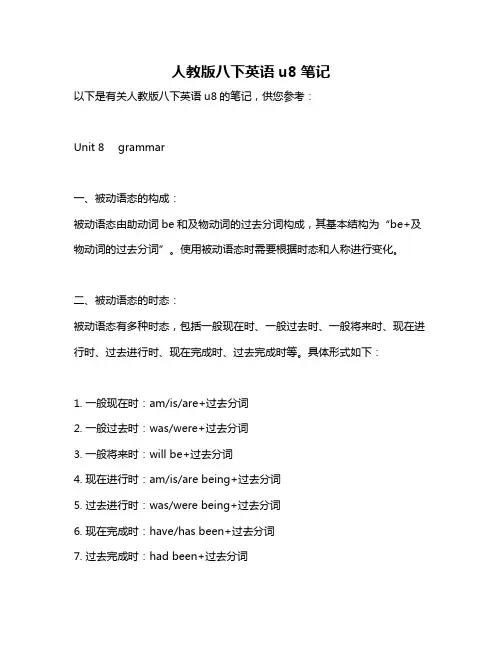
人教版八下英语u8笔记
以下是有关人教版八下英语u8的笔记,供您参考:
Unit 8 grammar
一、被动语态的构成:
被动语态由助动词be和及物动词的过去分词构成,其基本结构为“be+及物动词的过去分词”。
使用被动语态时需要根据时态和人称进行变化。
二、被动语态的时态:
被动语态有多种时态,包括一般现在时、一般过去时、一般将来时、现在进行时、过去进行时、现在完成时、过去完成时等。
具体形式如下:
1. 一般现在时:am/is/are+过去分词
2. 一般过去时:was/were+过去分词
3. 一般将来时:will be+过去分词
4. 现在进行时:am/is/are being+过去分词
5. 过去进行时:was/were being+过去分词
6. 现在完成时:have/has been+过去分词
7. 过去完成时:had been+过去分词
三、被动语态的用法:
被动语态常用于以下情况:
1. 不知道或不想指出动作的执行者。
2. 强调动作的承受者。
3. 在科技文献和新闻报道中,为了强调客观事实。
4. 在一些习惯用法中,如“It is said that…”(据说……)和“He will be invited to the party.”(他将受邀参加聚会。
)等。
四、主动语态与被动语态的转换:
将主动语态转换为被动语态的方法是将宾语变成主语,将谓语变成被动结构(be+过去分词),将原主语放在by后面,作为被动句中的宾语。
如果原主语不出现,被动句中常常以it作为形式主语。
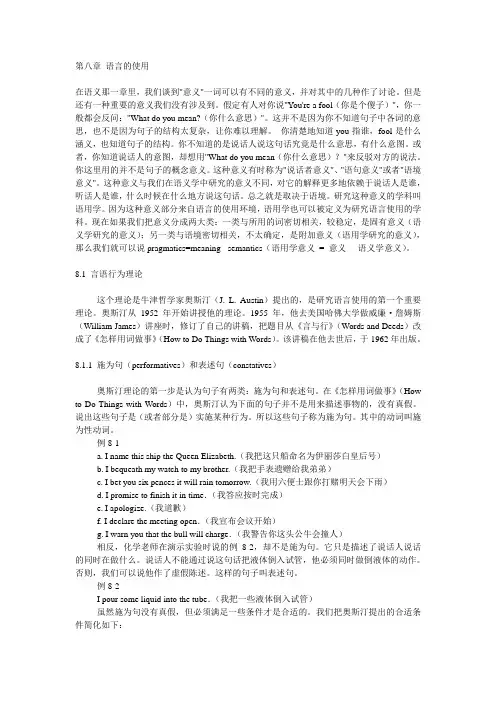
第八章语言的使用在语义那一章里,我们谈到"意义"一词可以有不同的意义,并对其中的几种作了讨论。
但是还有一种重要的意义我们没有涉及到。
假定有人对你说"You're a fool(你是个傻子)",你一般都会反问:"What do you mean?(你什么意思)"。
这并不是因为你不知道句子中各词的意思,也不是因为句子的结构太复杂,让你难以理解。
你清楚地知道you指谁,fool是什么涵义,也知道句子的结构。
你不知道的是说话人说这句话究竟是什么意思,有什么意图。
或者,你知道说话人的意图,却想用"What do you mean(你什么意思)?"来反驳对方的说法。
你这里用的并不是句子的概念意义。
这种意义有时称为"说话者意义"、"语句意义"或者"语境意义"。
这种意义与我们在语义学中研究的意义不同,对它的解释更多地依赖于说话人是谁,听话人是谁,什么时候在什么地方说这句话。
总之就是取决于语境。
研究这种意义的学科叫语用学。
因为这种意义部分来自语言的使用环境,语用学也可以被定义为研究语言使用的学科。
现在如果我们把意义分成两大类:一类与所用的词密切相关,较稳定,是固有意义(语义学研究的意义);另一类与语境密切相关,不太确定,是附加意义(语用学研究的意义),那么我们就可以说pragmatics=meaning - semantics(语用学意义= 意义- 语义学意义)。
8.1 言语行为理论这个理论是牛津哲学家奥斯汀(J. L. Austin)提出的,是研究语言使用的第一个重要理论。
奥斯汀从1952年开始讲授他的理论。
1955年,他去美国哈佛大学做威廉·詹姆斯(William James)讲座时,修订了自己的讲稿,把题目从《言与行》(Words and Deeds)改成了《怎样用词做事》(How to Do Things with Words)。
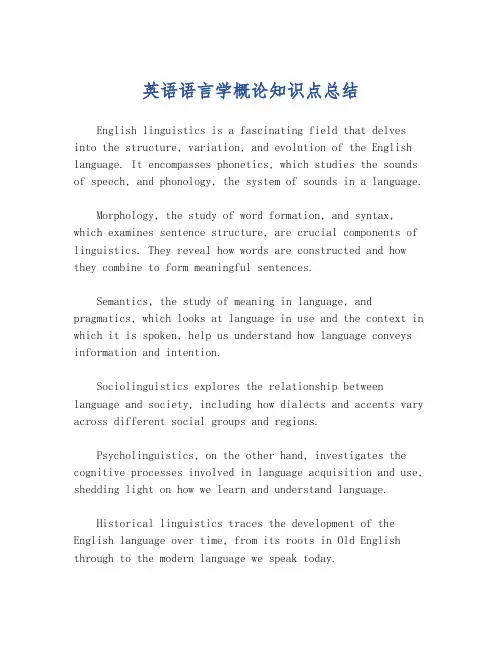
英语语言学概论知识点总结English linguistics is a fascinating field that delves into the structure, variation, and evolution of the English language. It encompasses phonetics, which studies the sounds of speech, and phonology, the system of sounds in a language.Morphology, the study of word formation, and syntax, which examines sentence structure, are crucial components of linguistics. They reveal how words are constructed and how they combine to form meaningful sentences.Semantics, the study of meaning in language, and pragmatics, which looks at language in use and the context in which it is spoken, help us understand how language conveys information and intention.Sociolinguistics explores the relationship between language and society, including how dialects and accents vary across different social groups and regions.Psycholinguistics, on the other hand, investigates the cognitive processes involved in language acquisition and use, shedding light on how we learn and understand language.Historical linguistics traces the development of the English language over time, from its roots in Old English through to the modern language we speak today.Finally, applied linguistics takes the theoretical knowledge from these areas and applies it to real-world problems, such as language teaching, translation, and language policy development.In summary, English linguistics offers a comprehensive view of the language, from its smallest units to its role in society, and from its past to its present and future forms.。
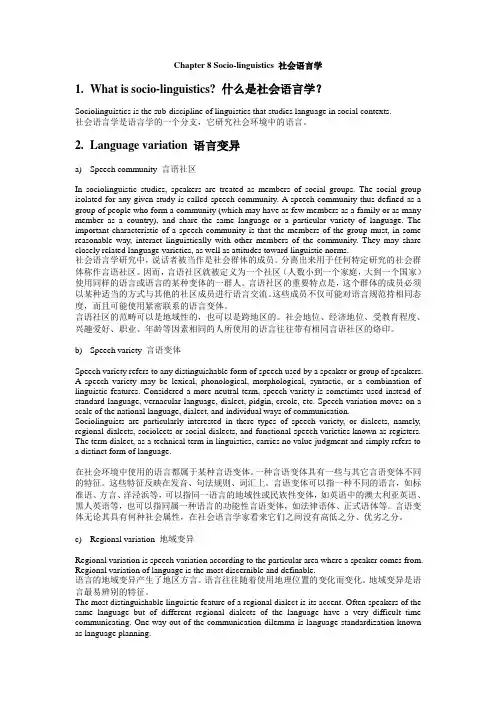
Chapter 8 Socio-linguistics 社会语言学1.What is socio-linguistics? 什么是社会语言学?Sociolinguistics is the sub-discipline of linguistics that studies language in social contexts.社会语言学是语言学的一个分支,它研究社会环境中的语言。
nguage variation 语言变异a)Speech community 言语社区In sociolinguistic studies, speakers are treated as members of social groups. The social group isolated for any given study is called speech community. A speech community thus defined as a group of people who form a community (which may have as few members as a family or as many member as a country), and share the same language or a particular variety of language. The important characteristic of a speech community is that the members of the group must, in some reasonable way, interact linguistically with other members of the community. They may share closely related language varieties, as well as attitudes toward linguistic norms.社会语言学研究中,说话者被当作是社会群体的成员。
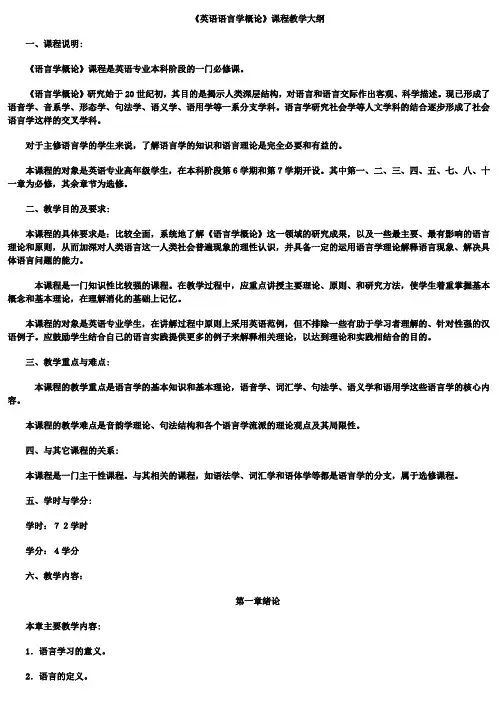
《英语语言学概论》课程教学大纲一、课程说明:《语言学概论》课程是英语专业本科阶段的一门必修课。
《语言学概论》研究始于20世纪初,其目的是揭示人类深层结构,对语言和语言交际作出客观、科学描述。
现已形成了语音学、音系学、形态学、句法学、语义学、语用学等一系分支学科。
语言学研究社会学等人文学科的结合逐步形成了社会语言学这样的交叉学科。
对于主修语言学的学生来说,了解语言学的知识和语言理论是完全必要和有益的。
本课程的对象是英语专业高年级学生,在本科阶段第6学期和第7学期开设。
其中第一、二、三、四、五、七、八、十一章为必修,其余章节为选修。
二、教学目的及要求:本课程的具体要求是:比较全面,系统地了解《语言学概论》这一领域的研究成果,以及一些最主要、最有影响的语言理论和原则,从而加深对人类语言这一人类社会普遍现象的理性认识,并具备一定的运用语言学理论解释语言现象、解决具体语言问题的能力。
本课程是一门知识性比较强的课程。
在教学过程中,应重点讲授主要理论、原则、和研究方法,使学生着重掌握基本概念和基本理论,在理解消化的基础上记忆。
本课程的对象是英语专业学生,在讲解过程中原则上采用英语范例,但不排除一些有助于学习者理解的、针对性强的汉语例子。
应鼓励学生结合自己的语言实践提供更多的例子来解释相关理论,以达到理论和实践相结合的目的。
三、教学重点与难点:本课程的教学重点是语言学的基本知识和基本理论,语音学、词汇学、句法学、语义学和语用学这些语言学的核心内容。
本课程的教学难点是音韵学理论、句法结构和各个语言学流派的理论观点及其局限性。
四、与其它课程的关系:本课程是一门主干性课程。
与其相关的课程,如语法学、词汇学和语体学等都是语言学的分支,属于选修课程。
五、学时与学分:学时:72学时学分:4学分六、教学内容:第一章绪论本章主要教学内容:1.语言学习的意义。
2.语言的定义。
3.语言的定义特征。
4.语言的起源。
5.语言的功能。
6.语言学的定义。
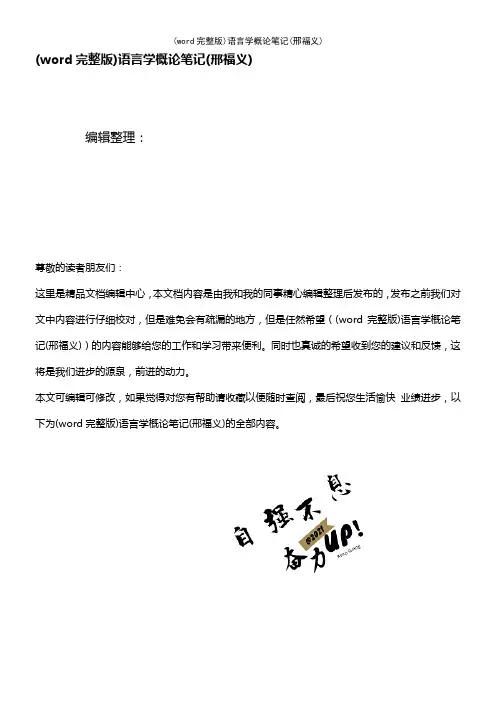
(word完整版)语言学概论笔记(邢福义)编辑整理:尊敬的读者朋友们:这里是精品文档编辑中心,本文档内容是由我和我的同事精心编辑整理后发布的,发布之前我们对文中内容进行仔细校对,但是难免会有疏漏的地方,但是任然希望((word完整版)语言学概论笔记(邢福义))的内容能够给您的工作和学习带来便利。
同时也真诚的希望收到您的建议和反馈,这将是我们进步的源泉,前进的动力。
本文可编辑可修改,如果觉得对您有帮助请收藏以便随时查阅,最后祝您生活愉快业绩进步,以下为(word完整版)语言学概论笔记(邢福义)的全部内容。
语言学概论第一章语言与语言学第一节语言的性质和范围一、为什么说社会性是自然语言的本质属性?为什么说语言是人类最重要的交际工具?二、什么是符号?语言符号有什么特点?三、语言和言语有什么区别和联系?四、口语和书面语有什么区别?为什么会有区别?五、什么是副语言和人工语言?二者有什么关系?1、语言:从结构上看,语言就是由词语这种符号构成的复杂系统。
从功能上看,是人类进行社会交际和思维认识的工具。
语言具有符号性、系统性、社会性及其他属性{民族性和生成性(指人们可以根据有限的语言符号和组合规则生成无限的句子)模糊性}2、语言的能指和所指(什么是符号):用甲事物代表乙事物,而甲乙两事物之间没有必然联系,甲事物就是代表乙事物的符号,其中甲事物就是符号的能指(形式),乙事物就是符号的所指(内容和意义)。
符号的能指和所指之间的关系是人为约定的。
3、语言符号的特征:语言中的词语就是一种符号,具有符号的特征。
1、语言符号的任意性(用什么能指代表什么所指是任意的)2、稳固性(语言符号一旦约定俗成以后就具有稳固性)3、渐变性(为了适应社会发展的变化,采取渐变的方式)4、线条性(语言符号在言语中只能有时间上的前后相继的关系)4、语言的社会性:语言是社会交际的工具,社会是语言的本质属性。
自然语言系统和规则是由特定的社会群体共同约定俗成的,而不是由个别人或少数人创造的语言的发展变化离不开社会,无论是新词语的产生,还是旧词语的消亡,都取决于社会交际的需要.由于自然语言从生到长到死的整个过程都取决于整个社会,所以说社会性是自然语言的本质属性。


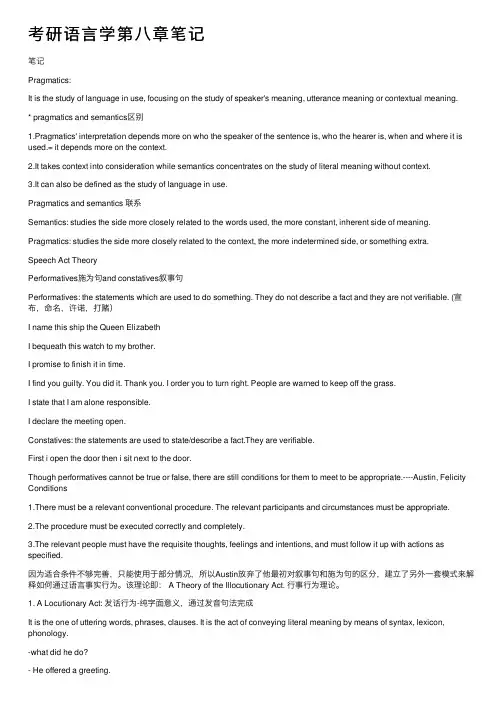
考研语⾔学第⼋章笔记笔记Pragmatics:It is the study of language in use, focusing on the study of speaker's meaning, utterance meaning or contextual meaning.* pragmatics and semantics区别1.Pragmatics' interpretation depends more on who the speaker of the sentence is, who the hearer is, when and where it is used.= it depends more on the context.2.It takes context into consideration while semantics concentrates on the study of literal meaning without context.3.It can also be defined as the study of language in use.Pragmatics and semantics 联系Semantics: studies the side more closely related to the words used, the more constant, inherent side of meaning. Pragmatics: studies the side more closely related to the context, the more indetermined side, or something extra.Speech Act TheoryPerformatives施为句and constatives叙事句Performatives: the statements which are used to do something. They do not describe a fact and they are not verifiable. (宣布,命名,许诺,打赌)I name this ship the Queen ElizabethI bequeath this watch to my brother.I promise to finish it in time.I find you guilty. You did it. Thank you. I order you to turn right. People are warned to keep off the grass.I state that I am alone responsible.I declare the meeting open.Constatives: the statements are used to state/describe a fact.They are verifiable.First i open the door then i sit next to the door.Though performatives cannot be true or false, there are still conditions for them to meet to be appropriate.----Austin, Felicity Conditions1.There must be a relevant conventional procedure. The relevant participants and circumstances must be appropriate.2.The procedure must be executed correctly and completely.3.The relevant people must have the requisite thoughts, feelings and intentions, and must follow it up with actions as specified.因为适合条件不够完善,只能使⽤于部分情况,所以Austin放弃了他最初对叙事句和施为句的区分,建⽴了另外⼀套模式来解释如何通过语⾔事实⾏为。
英语专业写作基础教程7-8单元笔记(共五则范文)第一篇:英语专业写作基础教程7-8单元笔记一、Definition and purpose of research paper定义:A research paper usually deals with an important issue, factual or theoretical, and it is usually fairly long and well-documented.目的:1.Learn how to use libraries, how to read books critically and efficiently, and how to use them wisely and correctly;2.Familiarize ourselves with the knowledge and mechanics necessary for writing a research paper;3.Gain some experience in writing long papers or reports.二、Steps of preparing research paperWe go through 5 steps or stages in the process of preparinga research paper:1.choosing a topic2.collecting information3.analyzing the information, organizing ideas, and working out an outline4.writing the first draft;and5.revising the draft and finalizing the paper.1.1 Ways of choosing a topic:(原则:from the general to the specific)①selecting a general topic(interested;already have some ideas;could develop it into a research paper)②③narrowing down the scope of our topic to a facet or facets which can be developed ④formulating the final topic1.2 Criteria for our final topic:It should be a topic①which is meaningful and serious.②which we are able to handle.③for which sufficient materials are available.④that can betreated objectively.⑤that is not too topical.2.1Ways of collecting information①using the library②reading③taking notes2.2How can we find books in library?We can find the books according to the first words of the titles of books or the;last names of the authors.2.3书目卡Calllast(姓),first(名)Number1城市:出版社,时间***p2.4 How are the books in libraries arranged?Books are arranged alphabetically according to their authors ,titles and the subjects they belong to.2.5How do you look for A Doll’s House?We go to the title catalogue file and look up Doll’s House and Color Purple ,ignoring the indefinite article “A” in the first book and the definit e article “The” in the second book.2.6 What do you do to get the information of E.M.Foster?We go to the author catalogue file and look up Foster, E.M., for the cards are arranged according to the last names of the authors.2.7 What is the right way of reading ?To read book quickly and critically.We may first look at the title of contents or the index to find out what chapter or parts of a book might give us some useful material.2.8 How can you be sure that your information is not outdated or biased ?We find the latest edition of the book and compare what is said in it with what other books say on the same topic to make sure that the information we have is not outdated or biased.2.9Rules of taking notes①take notes on cards, or on separate pieces of paper②place only one note on a card.③be selective.2.10 Kinds of information on a note carda.the fact, idea or opinion,b.the source.c.the author’s last name and the page number2.11 Kinds of notesa.the direct quotation(a note that takes down the exact wording of a particular effective statement on a subject)b.the paraphrase(a note that takes down the information of a source in our own words)c.the summary(a note that abstracts and condenses a large amount of material into a small space)Whichever method we use, we must cite the source of the information.如果原文有误,但仍就引用过来,须在后面标注[sic]。
《语言学教程》重点笔记(2020年)语言学教程笔记第一章语言学导论语言的定义特征:从本质上将人类语言与动物语言区分开的人类语言的区别性特点。
1.任意性:任意性是指语言符号的形式与所表示的意义没有天然的联系,任意性是语言的核心特征。
例如,我们无法解释为什么一本书读作a /buk/,一支钢笔读作a /pen/。
任意性具有不同层次:(1)语素音义关系的任意性。
(2)句法层面上的任意性。
(3)任意性和规约性。
2.二层性:二层性是指拥有两层结构的这种特性,上层结构的单位由底层结构的元素构成,每层都有自身的组合规则。
话语的组成元素是本身不传达意义的语音,语音的唯一作用就是相互组合构成有意义的单位,比如词。
因为底层单位是无意的,而上层单位有明确的意义,所以我们把语音叫做底层单位,与词等上层单位相对。
二层性使语言拥有了一种强大的能产性。
3.创造性:创造性指语言的能产性,指语言有制造无穷长句的潜力,这来源于语言的二层性和递归性。
利用二重性说话者可以通过组合基本语言单位,无止境地生成句子,大多数都是以前没有过的或没有听过的。
4.移位性:是指人类语言可以让使用者在交际时用语言符号代表时间上和空间上并不可及的物体、时间或观点。
因此我们可以提及孔子或北极,虽然前者已经去世两千五百五十多年而后者位置距我们非常之远。
语言使我们能够谈及已不存在或还未出现的事物。
移位性赋予人们的概括与抽象能力使人类受益无穷。
词在指称具体物体时,并不总是出现在即时、形象化的语境中。
他们通常为了体现指称含义而被使用。
5.文化传递性:语言不是靠遗传,而是通过文化传递的。
6.互换性:指人可以是信息的发出者,也可以是信息的接受者,即人作为说话者和听话者的角色是可以随意更换的。
元语言功能:我们的语言可以用来讨论语言本身。
比如说,我可以用“书”指代一本书,也可以用“书这个词”来指代“书”这个词本身。
这使语言具有无限的自我反身性:人类可以谈论“说话”,也可以思考“思考”。
专八语言学复习TEM-8 语言学知识复习总结第一节语言的本质一、语言的普遍特征(Design Features)任意性Arbitratriness 双层结构Duality多产性productive 移位性Displacemennt文化传播性Cultural Transmission二、语言的功能(Functions of Language)传达信息功能Informative:最主要功能The main functio n人际功能Interpersonal:establish and maintain their identity 行事功能performative:现实应用——判刑、咒语、为船命名等Judge,naming,and curses表情功能Emotive:表达强烈情感的语言,如感叹词/句exclamatory expressions寒暄功能Phatic:应酬话phatic language,比如“吃了没?”“天儿真好啊!”等等元语言功能Metalingual:用语言来谈论、改变语言本身,如book可以指现实中的书也可以用“book 这个词来表达作为语言单位的“书”三、语言学的分支1. 核心语言学Core linguistic语音学Phonetics 音位学Phonology 形态学Morphology 句法学Syntax.语义学Semantics 语用学Pragmatics2. 边缘语言学Peripheral:·心理语言学psycho-linguistics ·社会语言学socio-linguistics ·人类语言学anthropo-linguistics ·计算机语言学computer-linguistics四、语言学中几对基本概念1. 规定性研究Prescriptive与描述性研究DescriptivePrescriptive:着重于语言中“标准Standards”认为语言中存在着一种地位最高的语言形态,如标准语法/语音等,为规定人们如何说话、写作Descriptive:着重于语言中“事实Facts”,目的是描述人们一般是怎样说话、写作的2. 共时研究Synchronic和历时研究Diachronic3.语言Langue和言语Parole(由Ferdinand de Saussure索绪尔提出)Langue:指语言系统的整体the whole linguistic system,所有语言使用个体头脑中存储的word-image的总和,这个整体相对比较稳定。
语言学概论的读书笔记语言学概论的读书笔记篇1标题:语言学概论语言学是一门研究人类语言的科学,它涵盖了从语言的起源、发展、结构、功能到使用等各个方面。
这门课程由三位教授分别授课,他们从各自的研究领域出发,深入浅出地介绍了语言学的基础知识。
首先,王教授从语言的起源讲起,带领我们探讨了语言的本质和功能。
他认为,语言是一种社会现象,是人们交流思想和信息的工具。
通过深入浅出的解释和生动的例子,他让我们理解了语言的基本概念和语言习得的过程。
他还详细阐述了语言的功能,包括表达意义、社交互动、文化传承等。
接下来,李教授介绍了语言的分类和多样性。
他从全球视野出发,阐述了不同语言之间的差异和相似之处。
他强调了语言与文化的关系,认为每种语言都承载着一种独特的文化传统和价值观。
他还介绍了全球的语言政策和文化多样性保护等问题。
最后,张教授探讨了语言的结构和语法。
他从语音、词汇、语法等方面详细阐述了语言的构成要素。
他通过对比不同语言的语法结构,阐述了语言结构的发展和变化规律。
他还强调了语言习得和语言智能等方面的话题。
在这门课程中,我学习到了许多关于语言的知识和理论。
我对语言学这门学科有了更深入的了解,也对语言的功能和多样性有了更全面的认识。
同时,这门课程也让我认识到语言的重要性,以及保护和传承语言文化的意义。
总的来说,这门课程让我对语言学有了更深入的了解,也为我未来的学习和职业发展提供了有益的启示。
我相信,这门课程的知识和理论将会对我未来的学习和职业发展产生积极的影响。
语言学概论的读书笔记篇2语言学概论:探索人类沟通的奥秘在我阅读《语言学概论》这本书的过程中,我深感语言学是一门既深奥又有趣的学科。
它研究人类沟通的符号系统,从微观的语音学和句法学,到宏观的方言学和民族语学,涵盖了语言从发音到语法再到语义的各个方面。
本书的作者对语言学的基本概念和理论进行了深入浅出的介绍,包括语音、音韵、语法、语义、方言、语言习得等。
作者以清晰、简洁的语言,将复杂的理论娓娓道来,使我对语言学有了更深入的理解。
英语笔记第八单元以下是英语笔记第八单元的示例,包括重点词汇、短语、句型和语法知识。
重点词汇:1. vocabulary 词汇2. homophone 同音异义词3. antonym 反义词4. mnemonic 记忆法5. synonym 同义词6. prefix 前缀7. suffix 后缀8. morphology 形态学9. etymology 词源学10. cognate 同源词短语:1. a collection of words 词汇集合2. have a large vocabulary 词汇量大3. learn new words 学习新单词4. use mnemonics to remember words 使用记忆法记忆单词5. distinguish between homophones and synonyms 区分同音异义词和同义词6. study prefixes and suffixes 学习前缀和后缀7. understand the meaning of words 理解单词的意思8. trace the etymology of words 追溯单词的词源9. identify cognate words 识别同源词句型:1. I have a large vocabulary. 我词汇量大。
2. He is learning new words every day. 他每天都在学习新单词。
3. She uses mnemonics to remember words easily. 她使用记忆法轻松地记住单词。
4. They distinguish between homophones and synonyms in their vocabulary. 他们将同音异义词和同义词区分开来。
5. We study prefixes and suffixes to expand our vocabulary. 我们学习前缀和后缀以扩大词汇量。
regional dialects, sociolects or social dialects, and functional speech varieties known as registers. The term dialect, as a technical term in linguistics, carries no value judgment and simply refers to a distinct form of language.在社会环境中使用的语言都属于某种言语变体。
一种言语变体具有一些与其它言语变体不同的特征。
这些特征反映在发音、句法规则、词汇上。
言语变体可以指一种不同的语言,如标准语、方言、洋泾浜等,可以指同一语言的地域性或民族性变体,如英语中的澳大利亚英语、黑人英语等,也可以指同属一种语言的功能性言语变体,如法律语体、正式语体等。
言语变体无论其具有何种社会属性,在社会语言学家看来它们之间没有高低之分、优劣之分。
a)R egional variation 地域变异Regional variation is speech variation according to the particular area where a speaker comes from. Regional variation of language is the most discernible and definable.语言的地域变异产生了地区方言。
语言往往随着使用地理位置的变化而变化。
地域变异是语言最易辨别的特征。
The most distinguishable linguistic feature of a regional dialect is its accent. Often speakers ofthe same language but of different regional dialects of the language have a very difficult time communicating. One way out of the communication dilemma is language standardization known as language planning.语言地域变异的最显著特征是地域口音。
由于口音差异给跨地区的交流造成理解上的困难,推广标准化的运动便应运而生。
b)S ocial variation 社会变异Social variation gives rise to sociolects which are subdivisible into smaller speech categories which reflect their socioeconomic, educational, occupational and ethnic background, as well as their sex and age.语言的社会变异产生了社会方言。
社会方言又可以分为更小的语言类别。
导致语言社会变异的主要因素包括语言使用者的不同的社会地位、经济地位、学历、职业、年龄、性别等。
c)Stylistic variation 文体变异There are differences associated with the speech situation: who is speaking to whom about under what circumstances for what purpose.有一些差异是说话者本人的言语在不同的言语情景中所具有的差异:言语情景即在什么情况下,为了什么目的,谁与谁讲什么。
Stylistic variation in a person’s speech, or writing, usually ranges on continuum from casual or colloquial to formal or polite according to the type of communicative situation. Style can also refer to a particular person’s use of speech or writing at all times, or to a way of speaking or writing at a particular period of time, e.g., Dickens’ style, Hemingway’s style.根据交际情景的类型,一个人的口头语和书面语的文体会发生变化,变异区间是从随便文体或口语体到正式文体或文雅文体。
文体风格也可以指一个人一直在使用的口头语或书面语,或指在一个特定的时期内的说话或写作方式,如狄更斯的风格、海明威的风格。
d)I diolectal variation 个人言语变异When an individual speaks, what is actually produced is a unique language system of the speaker, expressed within the overall system of a particular language. Such a personal dialect is referred to as idiolect.一个人在说话时,他在一种特定语言的总的体系内表达,但他实际上所说出的是他自己的独特的语言体系。
这种个人方言被称为个人习语。
Idiolect is, thus, a personal dialect of anindividual speaker that combines aspects of all the elements regarding regional, social, and stylistic variation, in one form or another. In a na rrower sense, what makes up one’s idiolect includes also such factors as voice quality, pitch and speech rhythm, which all contribute to the identifying features in an individual’s speech.因此,个人习语是说话者的个人方言,它以这样或那样的方式综合了涉及地域变异、社会变异和文体变异的各方面的特征。
从比较狭窄的意义上来说,个人方言也包括音质、音调、言语节奏这样的因素。
这些因素都构成了个人言语中的可识别特征。
1.Standard and nonstandard languageThe standard language is a superposed, socially prestigious dialect of a language. It is the language employed by the government and the judiciary system, used by the mass media, and taught in educational institutions, including school settings where the language is taught as a foreign or second language.标准语是一种享有最高社会地位的语言变体,通常以在一个国家的政治、文化中心地区受过教育的本族语的口语和书面语为基础。
标准语为政府和司法部门采用,也用于新闻媒介、文学作品、正式的讲话或写作、正规教育以及对非本族语者的外语教育。
The standard language of many countries is also designated as the national or official language.许多国家的标准语同时被指定为全国语或官方语。
Language varieties other than the standard are called nonstandard, or vernacular, languages.不同于标准语的变体叫做非标准语,其发音、语法和词汇明显有别于公认的标准。
All dialects of a language are equally effective in expressing ideas.标准语和非标准语无优劣之分。
2.Diglossia and bilingualism 双言与双语现象a)D iglossia 双言现象Diglossia describes a situation in which two very different varieties of language co-exist in a speech community, each with a distinct range of purely social function and appropriate for certain situations. Usually, one is more standard variety called the high variety, or H-variety, which is used for more formal or serious matter, such as speeches made in government, the media, school, or church. And the other is a non-prestige variety called the low variety, or L-variety, which is used in colloquial and other informal situations, such as conversations with family or friends, or instructions given toservants, waiters, or workmen. Often the high variety is regarded as a literary standard called a classical language, whereas the low variety remains a local vernacular.双言现象并存于同一语言社区、用途各不相同的语言变体,通常其中一种被视为高层次变体,具有文言文的特征,另一种则为口语式的低层次变体。